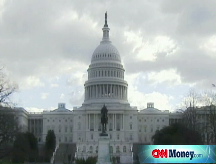Fed leaves rates near zero
Central bank says it is ready to take additional steps to get credit flowing, including purchasing long-term Treasurys.
NEW YORK (CNNMoney.com) -- The Federal Reserve kept its key interest rate near 0% Wednesday, and said it is prepared to take additional steps to try to fix the troubled U.S. economy and credit markets.
The Fed said it stands ready to purchase longer-term Treasurys if it determines that such a move will help get credit flowing once again. This may help lower the yield on the government bonds and further lower the rates on various types of loans tied to Treasurys.
Still, Treasury yields moved higher in the wake of the Fed decision, while Treasury prices, which move in the opposite direction, lost ground.
Experts said this was due to disappointment among some bond traders that the Fed did not announce specific plans Wednesday to buy Treasurys.
"They didn't say when and how much they would buy; they said they are prepared to do that," said Kevin Giddis, managing director of fixed income at Morgan Keegan. "The reality that they didn't give definitive terms has people running for the hills."
The central bank also gave a bleak outlook for the U.S. economy, saying that while it expected a "gradual recovery" to begin later this year, significant risks remain.
"Industrial production, housing starts, and employment have continued to decline steeply, as consumers and businesses have cut back spending," the Fed said in the statement. "Furthermore, global demand appears to be slowing significantly."
While the Fed said there had been improvement in some financial markets, it is concerned that credit remains tight.
The Fed also warned of a decline in prices that could further slow economic activity, a condition that is generally known as deflation.
Deflation often prompts businesses to further cut production and consumers to delay purchases because they anticipate lower prices to come. Economists warn that deflation can have a more destructive impact on the economy than inflation.
With that in mind, Sung Won Sohn, professor at Cal State University-Channel Islands, said he wishes the Fed talked tougher about fighting deflation.
"The deflationary threat is really the bottom line, and the Fed wants to do everything they can to minimize the risk," said Sohn. "I think the market would feel better if it knew that even more clearly."
But while economists agreed that there is little threat of inflation in the near term, some suggested the Fed's efforts to do anything it can to pump credit into the slumping economy could eventually lead to higher prices.
"In the short run, Fed easing is a plus," said John Silvia, chief economist at Wachovia. "Over the longer run, however, a long period of easy monetary policy may generate more problems down the road with a combination of higher inflation premiums and a weaker dollar to boot."
The Fed cut the federal funds rate, a benchmark used by banks to set rates paid on many types of consumer and business loans, to a range between 0% and 0.25% last month.
At that time, the Fed indicated that weakness in the economy would justify "exceptionally low levels of the federal funds rate for some time." That language was repeated in Wednesday's statement.
Although the Fed essentially has no room left to lower rates, it has taken numerous other steps to try and boost the economy and unlock tight credit markets.
The central bank has increased the amount of money that banks and Wall Street firms can borrow directly from the Fed.
It lent directly to major corporations through the purchase of commercial paper, used by companies to fund their day-to-day operations. It bought mortgage-backed securities to drive down mortgage rates.
In a new program set to start next month, the Fed will make more credit available to consumers and small businesses through more loans to banks.
The Fed's statement comes two day before the Commerce Department is due to report on the pace of the nation's economy in the last three months of 2008. Economists surveyed by Briefing.com forecast that economic activity fell at an annual rate of 5.4% in the fourth quarter, which would be the steepest drop reported in 26 years. ![]()



